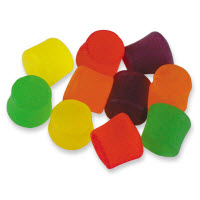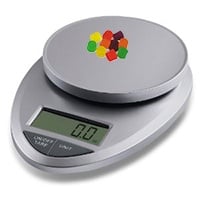Is Height Quantitative Or Qualitative
"Information! Data! Information! I can't make bricks without clay." Whether you lot're the world's greatest detective trying to crack a case or a person trying to solve a trouble at work, you're going to need information. Facts. Data, equally Sherlock Holmes says. But not all data is created equal, especially if you plan to analyze as part of a quality comeback projection. If you're using Minitab Statistical Software, you can access the Assistant to guide you through your analysis step-by-step, and help place the blazon of data yous have. But information technology's yet important to accept at least a basic agreement of the dissimilar types of data, and the kinds of questions y'all can use them to answer. In this post, I'll provide a basic overview of the types of data y'all're likely to encounter, and nosotros'll use a box of my favorite candy—Jujubes—to illustrate how nosotros tin can gather these unlike kinds of data, and what types of assay we might use it for. At the highest level, ii kinds of data exist: quantitative and qualitative . Quantitative data deals with numbers and things you lot can measure considerately: dimensions such equally height, width, and length. Temperature and humidity. Prices. Area and volume. Qualitative information deals with characteristics and descriptors that can't be easily measured, but can be observed subjectively—such equally smells, tastes, textures, attractiveness, and color. Broadly speaking, when you lot mensurate something and give it a number value, you create quantitative data. When you classify or guess something, you create qualitative data. So far, so good. Just this is only the highest level of data: in that location are also different types of quantitative and qualitative data. In that location are 2 types of quantitative information, which is also referred to as numeric data: continuous and discrete. Every bit a general rule, counts are detached and measurements are continuous. Discrete data is a count that can't be made more precise. Typically information technology involves integers. For instance, the number of children (or adults, or pets) in your family unit is discrete data, considering you are counting whole, indivisible entities: you can't take 2.v kids, or 1.3 pets. Continuous data, on the other paw, could be divided and reduced to effectively and finer levels. For example, you can measure out the height of your kids at progressively more precise scales—meters, centimeters, millimeters, and beyond—so height is continuous data. If I tally the number of private Jujubes in a box, that number is a piece of discrete data. If I use a calibration to measure the weight of each Jujube, or the weight of the unabridged box, that'southward continuous data. Continuous data tin be used in many different kinds of hypothesis tests. For example, to appraise the accuracy of the weight printed on the Jujubes box, we could measure out 30 boxes and perform a 1-sample t-test. Some analyses employ continuous and discrete quantitative data at the same time. For example, nosotros could perform a regression analysis to come across if the weight of Jujube boxes (continuous data) is correlated with the number of Jujubes inside (discrete data). When yous classify or categorize something, you create Qualitative or attributedata. There are three principal kinds of qualitative information. Binary data place things in ane of two mutually sectional categories: correct/incorrect, true/false, or accept/refuse. Occasionally, I'll get a box of Jujubes that contains a couple of private pieces that are either likewise hard or too dry out. If I went through the box and classified each piece equally "Good" or "Bad," that would be binary data. I could use this kind of data to develop a statistical model to predict how frequently I tin expect to get a bad Jujube. When collecting unordered or nominal data, we assign individual items to named categories that practise not accept an implicit or natural value or rank. If I went through a box of Jujubes and recorded the color of each in my worksheet, that would be nominal data. This kind of data can be used in many different means—for instance, I could use chi-foursquare analysis to see if there are statistically significant differences in the amounts of each colour in a box. We likewise can accept ordered or ordinal information, in which items are assigned to categories that exercise accept some kind of implicit or natural club, such equally "Curt, Medium, or Tall."Another instance is a survey question that asks u.s. to rate an item on a 1 to 10 scale, with 10 being the best. This implies that ten is better than ix, which is better than viii, and so on. The uses for ordered data is a matter of some debate among statisticians. Everyone agrees its advisable for creating bar charts, but beyond that the respond to the question "What should I practice with my ordinal data?" is "It depends." Here's a mail service from another blog that offers an fantabulous summary of the considerations involved. For more fun statistics you can exercise with candy, check out this article (PDF format): Statistical Concepts: What Grand&Grand'due south Can Teach Us. For a deeper exploration of the probability distributions that apply to dissimilar types of data, cheque out my colleague Jim Frost's posts nearly understanding and using detached distributions and how to place the distribution of your data.
— Sherlock Holmes, in Arthur Conan Doyle's The Adventure of the Copper Beeches The Two Principal Flavors of Data: Qualitative and Quantitative
Quantitative Flavors: Continuous Data and Discrete Data


Qualitative Flavors: Binomial Data, Nominal Data, and Ordinal Information

Additional Resources almost Information and Distributions
Is Height Quantitative Or Qualitative,
Source: https://blog.minitab.com/en/understanding-statistics/understanding-qualitative-quantitative-attribute-discrete-and-continuous-data-types
Posted by: gatewoodbeed1961.blogspot.com


0 Response to "Is Height Quantitative Or Qualitative"
Post a Comment